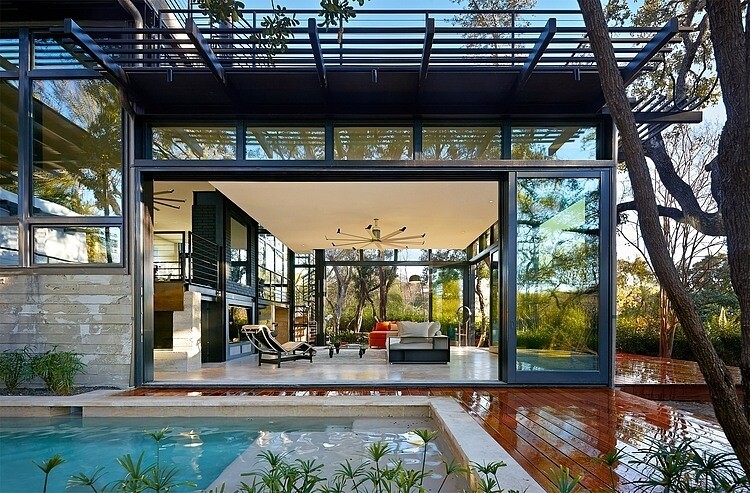Think back to the last time you walked into a beautifully designed home. What caught your eye? Chances are, white interior doors were subtly contributing to that feeling of elegance.
In today’s fast-paced design world, what makes these simple interior white doors so enduringly popular? Let’s explore!
Why Are White Interior Doors Still Popular in Modern Homes?
White interior doors have maintained their place as a design classic for decades. From sleek modern homes to traditional spaces, these internal white doors have proven to be much more than a passing trend. But what is it about white doors that makes them so timeless and beloved in interior design? Let’s take a closer look.
A Neutral Canvas for Every Design Style
One of the primary reasons white interior doors are so enduring is their incredible versatility. They act as a neutral canvas that complements a wide range of interior styles and color schemes. Whether your home embraces the sleek, minimalist aesthetic or is full of rich textures and colors, white doors effortlessly blend into any environment.
They allow other elements of your space—like bold furniture, vibrant artwork, or patterned wallpapers—to take center stage. The purity of white brings a sense of balance, offering the perfect backdrop without overwhelming the room. It’s this subtlety and flexibility that have made white doors a go-to choice for interior designers and homeowners alike.
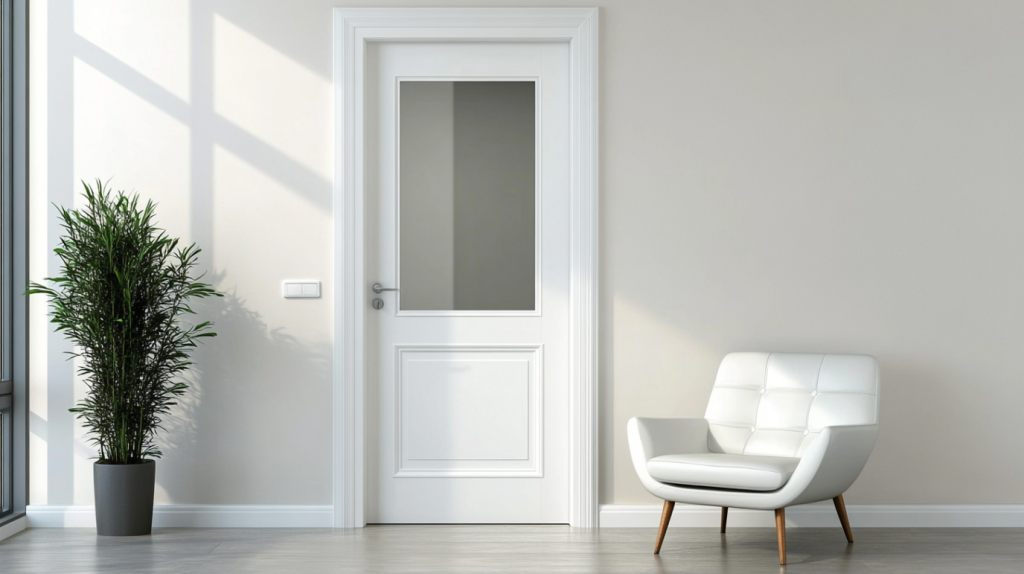
Creating a Sense of Space and Light
In addition to their aesthetic qualities, white interior doors have a practical advantage: they make rooms feel more spacious and brighter. White reflects light, which helps amplify the natural light coming into your home. This is especially important in smaller rooms or spaces with limited natural light. By opting for white doors, you can create an open, airy atmosphere that makes even the smallest of spaces feel larger.
Whether you’re working with a compact apartment or a large home, white doors help make rooms feel welcoming and expansive. The ability to instantly brighten a space with something as simple as a door is part of what makes them so enduringly popular.
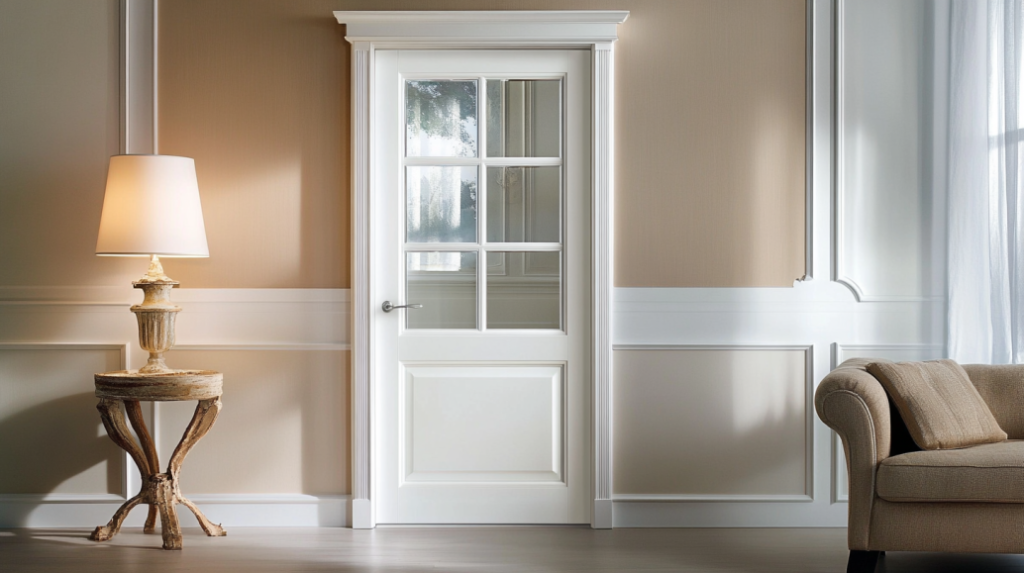
Easy to Pair with Modern Color Palettes
As design trends evolve, so do color palettes, but white doors continue to complement the newest trends in wall colors and decor. In recent years, deep and moody shades like charcoal grey, navy blue, and rich earthy tones have become popular. White doors serve as the perfect counterpoint to these darker colors, balancing them out without clashing.
Moreover, white works well with natural materials, like wood, stone, or even metals, all of which are increasingly seen in modern design. Whether you’re pairing them with a bright accent color or neutral tones, white doors have a unique ability to harmonize with any color choice, making them a foolproof option for any design scheme.
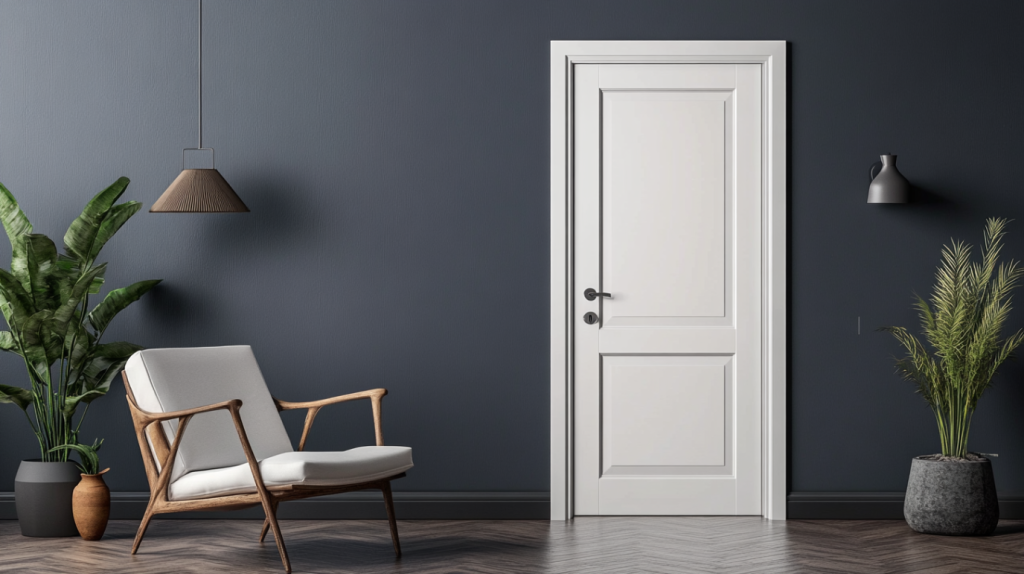
Boosting Home Value
There’s no denying that a well-maintained, well-designed interior can add significant value to your home. White interior doors, with their clean lines and timeless appeal, are a subtle yet impactful design feature that enhances the overall aesthetic of your home.
When selling your home or renting it out, potential buyers or tenants will be drawn to the neutral appeal of white doors. They are easy to integrate into any space and are seen as a high-quality feature, contributing to the overall marketability and value of your property. In this sense, white doors are not just a stylish choice—they are a smart investment in your home’s resale value.
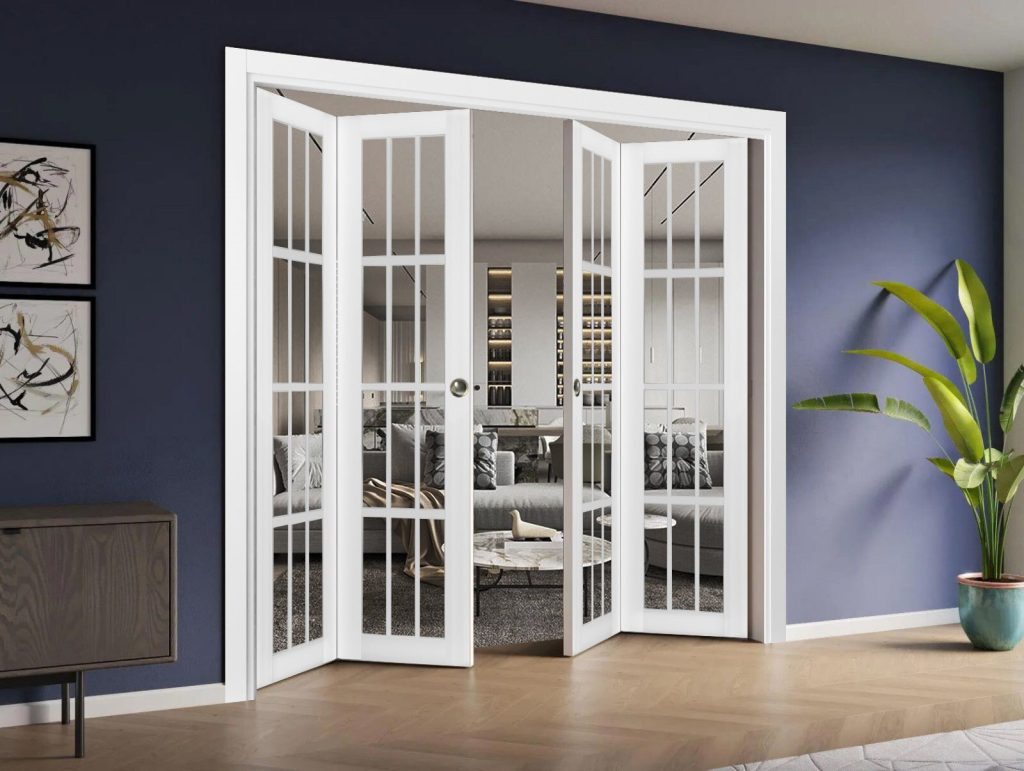
How Much Do White Interior Doors Cost?
Thinking about upgrading to white interior doors? It’s one of the smartest updates you can make. Before you buy white interior doors, you might be asking: How much do white interior doors cost?
White internal doors come in a variety of materials and styles, making the price range quite broad. Generally, you can find a basic white interior door starting at around $50, but the cost can quickly rise depending on the material, style, and customizations. For example, cheap white interior doors such as hollow core doors can be found for as low as $50 to $100, making them a budget-friendly option for homeowners. On the other hand, higher-end options like white doors with intricate white trim can cost anywhere from $200 to $600 or more, depending on the quality and design.
How Does Size Affect the Price of White Interior Doors?
Size plays a significant role in determining the cost of white interior doors. Standard doors are more affordable, while custom sizes or larger doors come with a premium. Below is an overview of how door sizes impact pricing:
| Size (Width x Height) | Price Range |
|---|---|
| 30" x 80" (Standard) | $50–$150 |
| 32" x 80" (Standard) | $60–$180 |
| 36" x 80" (Standard) | $80–$200 |
| 36" x 84" (Oversized) | $100–$250 |
| 42" x 80" (Oversized) | $150–$300 |
| 48" x 80" (Custom) | $200–$500 |
| 72" x 80" (Custom) | $300–$600+ |
Note: Prices are approximate and may vary based on retailer, location, and specific product features.
What Is the Best White for Interior Doors?
Choosing white seems simple, right? Until you stand in the paint aisle staring at a dozen swatches that all look… kinda the same. Suddenly, it’s not so easy. Picking the wrong white can make your doors look cold, yellow, or just “off.”
So, how do you find the one? The best white isn’t a single color. It’s the white that works in your home with your light.
Pure White
Best For: Modern, minimalist, and contemporary spaces.
Description: Pure white is the brightest, cleanest white. It offers a crisp, fresh look and works well in rooms where you want to maximize light and space. However, it can sometimes feel cold or sterile in warmer rooms, so it’s ideal for more neutral or cool-toned spaces. If you’re aiming for a sleek, modern vibe, pure white is a top choice.
Off-White
Best For: Traditional, rustic, and vintage-style homes.
Description: Off-white is a warmer version of white, often with hints of cream, beige, or gray. It’s perfect if you want the elegance of white without the harshness of pure white. Off-white tones create a softer, more inviting look, which is nice for spaces that need warmth. It pairs beautifully with natural wood, pastel colors, or classic decor styles.
Warm White
Best For: Rooms with earthy tones, wood accents, and cozy atmospheres.
Description: Warm white, often seen in shades like ivory or antique white, has undertones of yellow or brown, which adds a touch of warmth to the room. This shade is ideal for traditional or farmhouse-style homes and creates a welcoming, cozy feel. It’s perfect for rooms with lots of natural wood or softer color palettes.
Soft White
Best For: Rooms with earthy tones, wood accents, and cozy atmospheres.
Description: Warm white, often seen in shades like ivory or antique white, has undertones of yellow or brown, which adds a touch of warmth to the room. This shade is ideal for traditional or farmhouse-style homes and creates a welcoming, cozy feel. It’s perfect for rooms with lots of natural wood or softer color palettes.
Cool White
Best For: Contemporary spaces with a modern, clean design.
Description: Cool white has blue or gray undertones, giving it a crisp, airy look that works well in modern or industrial-style interiors. It’s perfect for spaces where you want a fresh, high-tech, or minimalist feel. Cool whites can complement sleek, metallic finishes, glass, and monochrome color schemes.
-
💡
Pro Tip: 1. Consider the lighting in your room: A warm white might feel too yellow with lots of natural light, while a cool white might seem harsh in dim lighting. 2. Match the finish to your style: Matte finishes give a subtle look, while glossy finishes make white doors appear brighter and more modern. 3. Pair your white doors with your wall colors: Cool whites may clash with warm walls, while off-white or soft white blends better with warmer tones.
How to Choose the Right Type of White Interior Door?
Feeling overwhelmed by the many interior white door options? It’s understandable. Choosing the right door is about more than just color—it’s about style, material, and fitting the right door to your space. Let’s simplify this decision by breaking down what works best for different needs and budgets.
1
For the Budget-Conscious: Hollow Core Doors
If you’re looking for an affordable solution, hollow core doors are your best bet. These doors are lightweight, often made with an MDF surface and a honeycomb core. They’re easy to install and budget-friendly, but they’re best suited for areas where durability and soundproofing aren’t top priorities.
Best for: Closets, pantries, laundry rooms, and low-traffic areas.
Think twice if: You need noise insulation or have kids or pets. Hollow core doors may feel flimsy and can wear down over time.
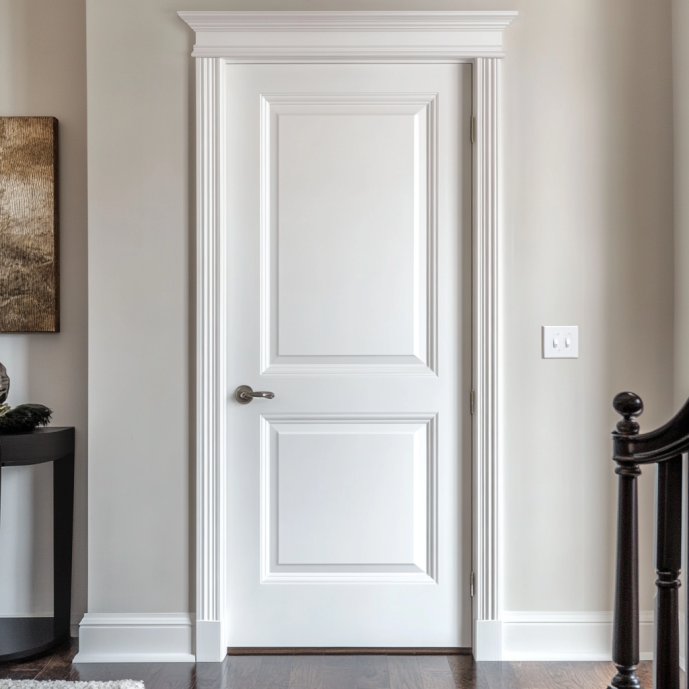
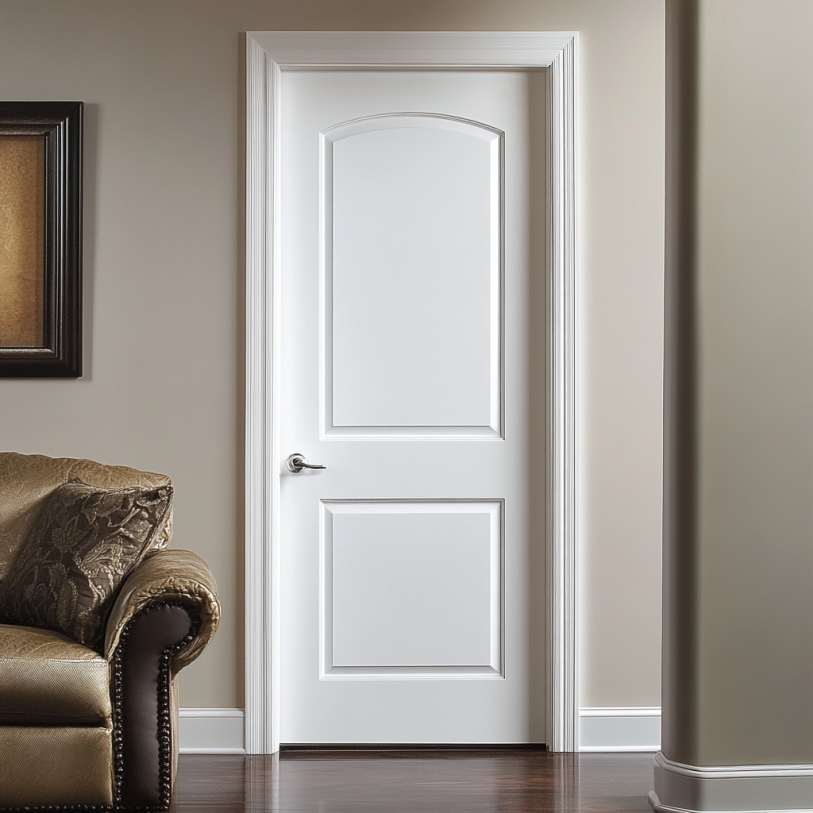
2
The Popular Choice: Solid Core Doors
Solid core doors strike the perfect balance between cost and performance. These doors are heavier, made with a solid particleboard or composite interior wrapped in MDF. They offer excellent sound insulation and a high-end feel without the premium price tag of solid wood.
Best for: Bedrooms, bathrooms, and home offices. They provide good soundproofing and a substantial, quality feel.
Pro Tip: Solid core doors are often recommended by designers as they offer a great mix of affordability, style, and functionality.
3
The Investment Piece: Solid Wood Doors
For a timeless and durable option, solid wood doors are unmatched. Made from woods like pine, oak, or poplar, these doors are heavy and built to last. While they come at a higher cost, they offer character, longevity, and the ability to be sanded and refinished over time.
Best for: Historic homes, high-traffic areas, or those looking for the best in durability and style.
Keep in mind: Solid wood doors are the priciest option and often require professional installation due to their weight.

4
The Style Spotlight: It's All About the Design
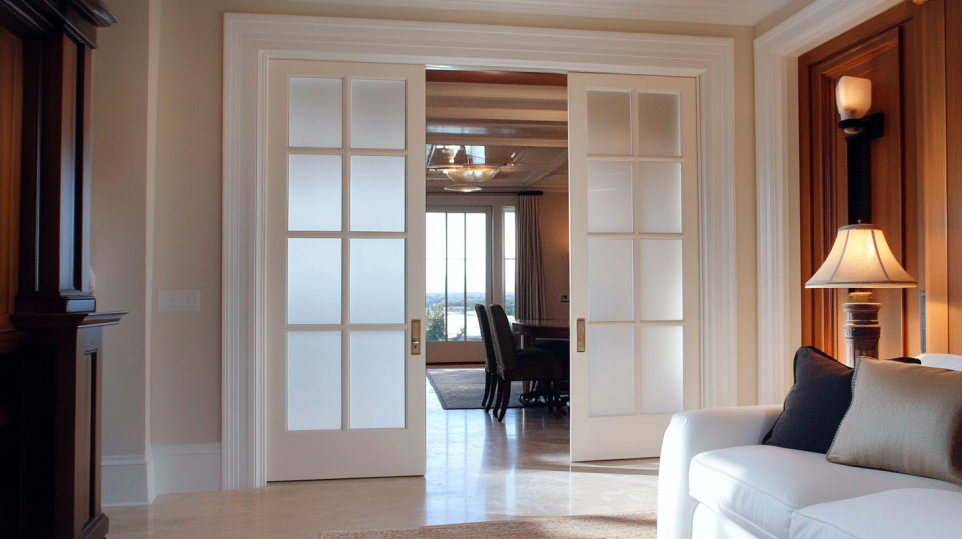
The material is just half of the equation. The door design plays a huge role in defining your home’s character. For a sleek, modern look, a slab door with a flat, minimalist profile fits perfectly in contemporary spaces. If you prefer something timeless and versatile, Shaker doors with their simple five-panel design can work in almost any style of home. For an elegant touch that lets light flow between rooms, French doors are an ideal choice. Lastly, for tight spaces or a rustic charm, a barn door is an excellent functional option that adds unique character while saving space.
Where to Buy White Interior Doors?
Finding the right interior doors supplier is just as important as choosing the style. While big-box stores offer convenience, they often lack customization and premium quality. For those seeking exceptional value without compromising on design or durability, PA Home stands out as a top choice.
Why PA Home is the Top Custom Interior Door Manufacturer in China?
PA Home is China’s top interior door manufacturer. Our doors blend the elegance of Italian design with traditional craftsmanship, creating functional pieces that enhance the visual appeal of any space. Whether you’re after modern, sleek doors or more classic, timeless designs, PA Home offers a wide selection to suit your style.
As one of the top 10 whole-house customization manufacturers, we optimize our production processes, enabling us to pass significant cost savings directly to you. This means you can access premium doors at incredibly low, factory-direct prices, often comparable to wholesale rates typically offered to contractors and large projects.
At PA Home, we make interior doors affordable for everyone without compromising on quality. Ready to transform your space with the best interior doors on the market? Contact us today for more information and to receive your personalized quote. Let PA Home help you make the right choice for your home!
FAQs about White Interior Doors
Provide practical advice on whether baseboards should match doors or if mixing whites is acceptable, based on room style and personal preference.
White oak shows real wood grain with a natural or white-wash finish. Painted white doors look crisp and uniform but hide the grain.
Expect mid-to-high pricing. Slab solid-core white oak veneers often start mid-range; solid white oak runs higher. Custom sizes, glass, and premium hardware add more.
Not if you upgrade hardware, use crisp semi-gloss, and tighten reveal gaps.
Standard sizes, fast: Most interior slabs are 1-3/8″ thick; heavier doors are 1-3/4″. Height is usually 80″; tall options are 84″ or 96″. Common widths are 24″, 28″, 30″, 32″, 36″. For accessibility, pick a 36″ door to get a 32″ clear opening.


